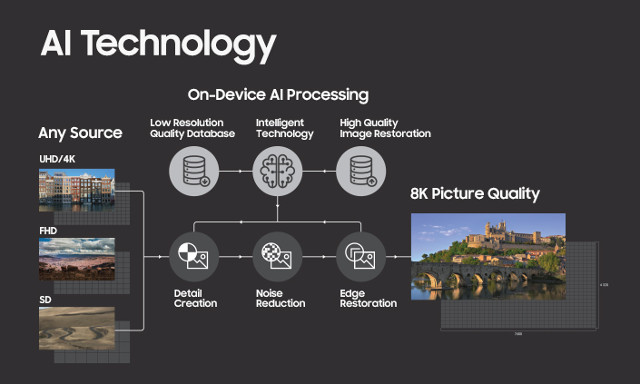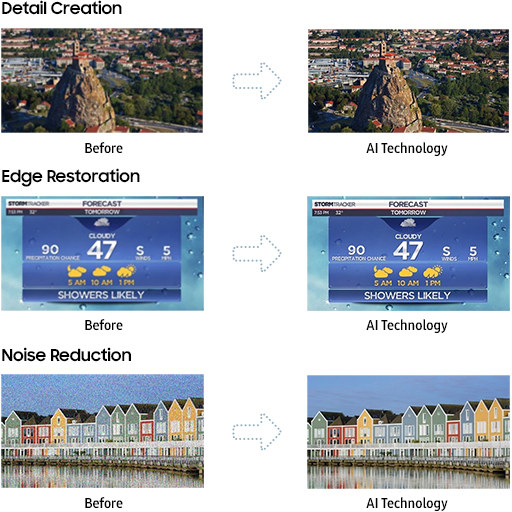You’ve probably read how artificial intelligence can be applying to modify photos, either repair them, or change the weather in photos from sunny to rainy, and vice versa. Samsung unveiled an 85″ 8K QLED TV right before CES 2018, which should be news by itself, but that I found really intriguing is the TV’s artificial intelligence capabilities that will upscale standard and other resolution content to 8K resolution.
The TV will take SD, Full HD or 4K sources runs it through machine learning algorithm to re-create details, reduce noise, and restore edges to bring them back to 8K picture quality. Not your usual “dumb” upscaling 🙂
The TV is said to be equipped with a database that studies and analyzes millions of images in advance to transform low-resolution content into high-resolution, and capable of selecting the optimal filter to convert the source to higher quality. Samsung then explains the images is processed 64 times (how?) to offer natural images in high resolution, and finally elements of picture quality (black/blooming/brightness) are categorized in the input sources to produce pictures with more detailed contrast.
Samsung’s AI technology can also optimize audio for specific scenes, for example the audio from spectators may be amplified while watching sports events, or low-frequency sounds be highlighted while watching concerts.
This will be interesting to find out how well that works, and if it does we can eventually (i.e. in several years) expect some changes in the way video is streamed. For example, if somehow it becomes possible to obtain 8K quality while streaming SD quality videos, then content providers would then likely send low bitrate SD resolution data to compatible devices, and let them upscale content to 8K or whatever native resolution the TV supports. That seems to good to be true so wait and see. Alternatively (more likely?), this could become a fallback option when network connectivity is not good enough for 8K content.
While Samsung is showcasing an 85″ 8K TV at their event, the company will also launch 65″ and greater 8K QLED “A.I.” TVs in H2 2018. The company also introduced that they call “the wall” at the event, a 146″ modular TV featuring self-emitting MicroLED technology promise lower power consumption, and longer life time.

Jean-Luc started CNX Software in 2010 as a part-time endeavor, before quitting his job as a software engineering manager, and starting to write daily news, and reviews full time later in 2011.
Support CNX Software! Donate via cryptocurrencies, become a Patron on Patreon, or purchase goods on Amazon or Aliexpress







It is possible to improve the appearance of an image to better suit the human eye. But it’s not possible to add detail where none existed before.
Basically, the AI is being asked to guess what a higher resolution *might* look like. And the obvious problem with guessing is that guesses are sometimes wrong. Comparing an enhanced image to an actual higher resolution image should reveal some of these anomalies. And the greater the enhancement, the more obvious it will become.
Example: Things like smoke will likely be mis-construed as noise.
@jqpabc123
true but i believe these are the first baby steps
there is no reason why a much more advanced ai will be able to make a sd copy look like uhd
It is worth remembering that a badly done film is still a badly done film even in 8k, 4k or HD.
Content and desire to watch are still kings, IMHO.
Clearly it is time for CNX to appeal to the dear readers to send money to buy one of these to see if the AI upscaling really does make a difference (and replace the broken and out of date LG with nasty banding artifacts). You know it makes sense!
And yes, “Santa Claus Conquers The Martians” (1964), “The Room” (2003), “Sex Lives of the Potato Men” (2004) [with funding from the UK National Lottery], the 10 hour “Paint Drying” (2016), and the 8 hour “Baa Baa Land” (2017) will be just as astonishgly, execrably, and painfully bad in upscaled 8k.